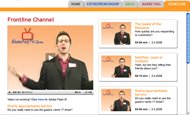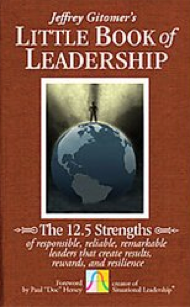 In Bob Dylan’s bestselling book, Chronicles, he spends a lot of time talking about performing, captivating audiences and playing concerts around the globe for millions of screaming fans.
In Bob Dylan’s bestselling book, Chronicles, he spends a lot of time talking about performing, captivating audiences and playing concerts around the globe for millions of screaming fans.
Here’s my favorite passage:
“I don’t do it for the money, I do it because I was summoned set the record straight.”
That’s how he owned the room.
By giving people more than just a vague glimmer.
By plunging straight into the heart of unimagined territory.
By helping people see what lies beyond the mystery curtain.
Here’s how to make it work for you:1. Understand room equity. This is a term I coined a few years ago when I wrote The Approachable Leader. And it hinges upon two key questions: When you walk into a room, how does it change? When you walk out of a room, how does it change?
That’s the thing: Owning the room isn’t about being larger than life – it’s about making the room larger by injecting it with life.
It’s not about controlling people – it’s about acting like the audience is your people. It’s not about being the most important person in the room – it about embodying the most important idea in the room. And it’s not about waiting for people to respond to your very presence – it’s about enlarging people so much that they wonder who was responsible.
That’s the first challenge: To think about your current level of room equity. Because whatever change occurs to the room is a tangible representation of how your character, reputation and personality have been experienced by the people around you. Remember: It’s not just how people experience you – it’s how they experience themselves in relation to you. What is the temperature of your presence?
2. The show started a year ago. If you’re waiting until your performance starts, it’s already too late. That’s the big misconception about room ownership: It commences long before you walk in the door. It’s not about leveraging power phrases, employing strategic hand gestures or yakking out a steady stream of rhetorical devices.
It’s about living your life in a way that creates an honorable, attractive and intriguing reputation that’s waiting for you when you walk in the door. And it’s about engaging your fans in a conversation that’s honest, prompt and personal so they’re waiting with baited breath when you walk on stage.
That way, all you have to do is smile, set yourself on fire and let people watch you burn.
Remember: If you just started preparing for it the night before the performance, you’ve lost your audience long before you walked in the door. Are people waiting with baited breath to hear your very first words?
3. Charts are recorded, but experiences are remembered. Because Bob Dylan started performing in the mid to late fifties, most of his early influences were jazz and blues greats like Miles Davis. And according to the book, Miles never actually made any hit records. But according to Dylan, his legendary performances brought people back, with their friends and with their money.
If you want to do the same, consider these suggestions: First, show people a side of themselves they didn’t know was there. They’ll believe in possibilities they wouldn’t have allowed before. Second, sustain visual, verbal and interactional diversity. When you perform, make sure people are participating – not just staring.
Third, stop treating your audience like children. Come at people like they don’t have a brain and they’ll come at you like they don’t have a wallet. Fourth, surrender control. Crowd source your performance. All the audience to become co-creators of the experience.
Remember: As technology accelerates, and as people become more isolated from each other, there is a growing craving for live experience. Be someone who delivers that, and the room will be yours. Are you trying to be number one or trying to be the only one?
4. Capture heartshare. As a professional speaker, I’ve certainly fallen victim to the fantasy that I’m changing people’s lives. And maybe I am. But sometimes all your audience just wants is to be validated. To feel like they’re not alone. And to know that they’re not the only people who feel a certain way.
If you can bring that kind of sanity into a world of madness – your voice will never drop out of sight.
Here’s my suggestion: Instead of telling pointless, meandering stories; start positioning yourself as the mirror in which people can see a clearer picture of themselves. It makes it easy for your audience to transplant themselves into your message.
Plus, it increases the memorability of your delivery. After all: Being memorable has less to do with you, and more to do with how people experience themselves in relation to you.
The point is: If your message can simply remind people that they’re not the only ones cluelessly staggering through this world, you won’t have to change people’s lives – because they do it for themselves. All you had to do was give them the tap. Are you leaving your audience begging for more or begging for mercy?
5. Tactical is rarely timeless. If you want your performance to be wholly engrossing, give people ideas that will be relevant in fifty years. That’s the stuff of real flesh and blood. Otherwise you’re just dispensing tactics. And if people can get those online – for free – what do they need you for?
Consider these ideas: First, avoid getting caught in the seductive undertow of trendy inconsequentialities. Strategies are nice, but eventually they will reach the end of their product lifecycle. Which means you’ll have to start over. Second, design matters. Always. No matter what you do, how you do it, why you do it, and whom you do it for, beauty makes you timeless. Make friends with it.
Third, speak with a transcending tongue. Go straight to the heart of the human experience. And allow the theme behind what you do to speak louder than the era in which you do it. Finally, peel away the superficiality of your message. Instead of firing off a bunch of depthless trivialities, coat your voice in blood. Personal becomes universal, and universal lasts forever.
Look: There’s nothing more frightening than the prospect of irrelevancy. It’s always worth investing extra time in making your message more timeless. What are you doing to keep from fading away?
6. Dare to live by a different script. Never let people forget that you have your own way of seeing things. That’s why you got into art in the first place: As a mechanism for defining the way you think about the world. And if you want to share it with the people who matter most, remember the advice of hockey legend Tony Twist, “Don’t be afraid of hitting people too hard.”
You have to look the world straight in the eye, be blazingly honest and let your artistic spirit fill the room like a smoke machine. Because if all you do is mutter through locked teeth, your work won’t stand a chance of meaning anything. If all you do is conveniently ride the coattails of someone else’s truth, your voice will remain stale and colorless.
I’ve seen performances that made me want to drive my car over a cliff. But I’m thankful every time it happens, because it reminds me of what it truly takes to own the room: Authentic stylistic identity.
Vowing to follow your own heart’s love. Keeping your word with yourself, no matter what happens. And knowing that when you sing the true song of your soul, you speak in a language that people can’t misunderstand. Are you addicted to permission or indifferent to approval?
REMEMBER: Owning the room has less to do with you, and more to do with how people are better off from listening to you.
Practice that, and, as Bob Dylan sang, “You ain’t going nowhere.”
LET ME ASK YA THIS…
Do you own the room?
LET ME SUGGEST THIS…
For the list called, “11 Things to Stop Wasting Your Time On,” send an email to me, and you win the list for free!
* * * *
Scott Ginsberg
That Guy with the Nametag
Author, Speaker, Publisher, Artist, Mentor
[email protected]
 Never the same speech twice.
Never the same speech twice.
Now booking for 2011-2012!
Watch The Nametag Guy in action here!


 Have you ever been in a committed relationship with someone that you loved completely and devoted yourself to fully – who was totally wrong for you?
Have you ever been in a committed relationship with someone that you loved completely and devoted yourself to fully – who was totally wrong for you? 
 Humans want freedom.
Humans want freedom. I was never any good at math.
I was never any good at math. Relationships work when you work at them.
Relationships work when you work at them. In Bob Dylan’s bestselling book, Chronicles, he spends a lot of time talking about performing, captivating audiences and playing concerts around the globe for millions of screaming fans.
In Bob Dylan’s bestselling book, Chronicles, he spends a lot of time talking about performing, captivating audiences and playing concerts around the globe for millions of screaming fans. There’s no reason to be mean.
There’s no reason to be mean. “I usually refuse to pay for mentoring. But after Scott’s first brain rental session, the fact that I had paid something to be working with him left my mind – as far as I was concerned, the value of that (and subsequent) exchange of wisdom and knowledge, far outweighed any payment.”
“I usually refuse to pay for mentoring. But after Scott’s first brain rental session, the fact that I had paid something to be working with him left my mind – as far as I was concerned, the value of that (and subsequent) exchange of wisdom and knowledge, far outweighed any payment.” To celebrate the release of Jeffrey Gitomer’s new book,
To celebrate the release of Jeffrey Gitomer’s new book,